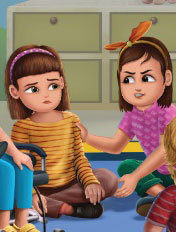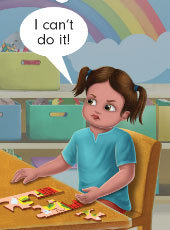Why Are Children Acting That Way? Oh, and How Are You Responding?

What behaviors and interactions do you see in your young students that are particularly concerning? What does that behavior look like? Is it disruptive or explosive?
 |  |
Are children inattentive or not following directions?
 |  |
What other things do you see? Oh, and what is your response and reaction when children display undesirable behavior?
“When a child misbehaves, don’t get angry, get curious!” advises Katherine Reynolds Lewis in her book, The Good News About Bad Behavior: Why Kids Are Less Disciplined Than Ever, and What to Do About It (2018). One consideration is to get curious about what children haven’t learned yet. There is a good chance undesirable behaviors are a result of underdeveloped social-communication and executive function skills. Another, and maybe even more important consideration, is to get curious about why undesirable behaviors may be persisting in your setting. Chances are persistent behavior is being reinforced, somehow.
A few points about the first consideration…Social-communication skills, which are supported by executive function abilities, are required for successful interactions. There is an interconnected and reciprocal nature among these three foundations: Communication, executive function, and social-emotional learning. Communication develops as young children understand and use increasingly complex language. They learn to express themselves and participate in conversations, and they learn the social rules of language.
Executive function skill development contributes to and is supported by communication development (Zelazo et al, 2017). As young children learn more about language, they learn to use flexible thinking and consider the perspectives of others. As executive function skills grow, children can keep information in mind and be more attentive. They develop better self-regulation skills by learning to resist distractions and tolerate frustration better as well as learning to persist in tasks. All these skills support communication and social-emotional development.
Social-emotional learning is dependent on and supported by communication and executive function development. Children learn to express a range of feelings for themselves and others, which requires oral language and flexible thinking. They learn to engage in social interactions with others, participate in group situations, and to solve social problems to resolve conflict. Again, the foundations for these skills are communication and executive function (Gilkerson et al. 2018; Gomez & Stosser, 2021).
A few points about the second consideration…Children do not naturally discover how to communicate and interact on their own. They need intentional instruction and many opportunities to learn and practice prosocial and interaction skills (Murano et al., 2020). When children are not provided with the needed guidance, they may display undesirable behaviors because they don’t have another strategy and/or their behaviors may be getting reinforced in subtle and, sometimes, unexpected ways.
Think about a situation when a preferred object was not available to a child. He or she may respond by throwing a fit, grabbing it from someone else, or loudly demanding it. Results of short-term consequences of tantrums, physical aggression, and verbal explosions are that children often get what they want, which is highly reinforcing. They need guidance trying other prosocial options.
Our reaction to undesirable behavior may also be subtly reinforcing it and may contribute to even bigger emotions. Something as simple as saying “Don’t run” calls attention to the running behavior but doesn’t provide a description of the desired behavior such as “Use your walking feet.” Asking a child why he or she hit someone else gives the hitter a lot of the adult’s attention. Calling out the undesirable behavior provides a good deal of attention to what you don’t necessarily want to see and, importantly, doesn’t provide guidance for a more expected or desired behavior. Your emotional state will also influence children’s response and reaction. An angry reaction to a behavior may escalate a child’s big emotions, whereas a calm response may help to resolve the situation.
Children need guidance from responsive, engaged, and interactive care providers who model, teach, practice, expect, and reinforce desired and expected behaviors. Here are some key tips for helping children develop desired social-communication skills and for the types of interactions we can provide them:
- Emotional regulation: Children need to be regulated to be effective learners. So do we. Our own internal emotional state will be reflected in the actions and behaviors of others and vice versa. This powerful interaction is known as mirror neurons. Identify your own emotional state. An angry voice tone from caregivers can be mirrored by children who, themselves, may be dysregulated, which can then escalate the challenging behavior and big emotions. A calm voice tone can also be mirrored. Children feel your calmness, which may help to get them back into a better emotional balance. Model regulation for the behaviors you would like to see.
- Self-regulation: Help children develop self-regulation skills by intentionally having them monitor their own behavior. Provide a concrete strategy that helps them check in with their legs, hands, eyes, ears, and brains, to see if they are in control of their bodies.
- Conversational turn-taking: Engaging children in conversational turns is one of the best strategies for helping children develop oral language, executive function, and social-emotional skills. “Strive for five” back-and-forth turns with young children often throughout the day. Watch their social-communications skills flourish.
- Responsive instead of reactive: Have a plan to intentionally teach the skills children need to successfully interact with those around them. Teach and model expected behaviors (I Do) and have children practice them (We Do), then provide opportunities for children to engage in social communication contexts (You Do) in supportive and regulated ways.
Reflect on the behaviors you find concerning. Be curious about the skill or skills that may be underdeveloped and need more instruction and guidance. Be curious about how your reaction or response might reinforce the undesired behavior.
There are many things we can do to provide a socially responsive environment and intentional instructional routines to help children develop the skills they need to successfully interact and engage with others. These social communication skills develop relationships and enhance learning, leading to school and life success. We all want children to grow, develop, and thrive!
Gómez, E., & Strasser, K. (2021). Language and socioemotional development in early childhood: The role of conversational turns. Developmental Science, 24(5), e13109.
Lewis, K. R. (2018). The Good News About Bad Behavior. PublicAffairs.
Murano, D., Sawyer, J. E., & Lipnevich, A. A. (2020). A meta-analytic review of preschool social and emotional learning interventions. Review of Educational Research, 90(2), 227-263.
Paulson, L. H. Attridge, L., & Avenetti, L. (2023). Good Talking Words: A Social Communication Skills Program for Early Childhood Classes. Voyager Sopris Learning, Dallas, Texas.
Romeo, R. R., Leonard, J. A., Grotzinger, H. M., Robinson, S. T., Takada, M. E., Mackey, A. P., ... & Gabrieli, J. D. (2021). Neuroplasticity associated with changes in conversational turn-taking following a family-based intervention. Developmental cognitive neuroscience, 49, 100967.
Zelazo, P. D., Blair C., & Willoughby, M. T. (2017). Executive function: Implications for education. National Center for Education Research. https://ies.ed.gov/ncer/pubs/20172000/pdf/20172000.pdf

